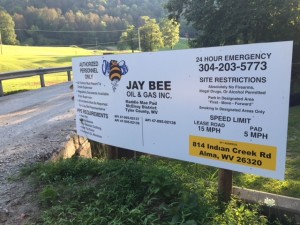From the Article by David Beard, Morgantown Dominion Post, December 13, 2019
Apart from the trip, WVONGA and The Dominion Post conducted a written Q&A about industry practices in general. Here are highlights.
Q: How do you evaluate if a road needs repair?
A: Road conditions are evaluated throughout all phases of well development. During the pre-construction phase, engineering consultants evaluate existing conditions to determine if roads will safely accommodate truck traffic. That process includes pavement sampling and surveying to determine lane width, turning radius and other safety issues. They also evaluate drainage. If it is determined that a road will not sufficiently handle traffic, companies will propose a road improvement project. Companies work with the WVDOH to secure agreements and approve plans.
“During a project, companies monitor conditions and conduct periodic repairs if needed. The WVDOH also monitors roads. Asphalt repairs are conducted when surface conditions require maintenance.
“In most instances, roads are in better condition than they were prior to the project due to the work the oil and natural gas companies perform before, during, and after their projects.”
Q: Do you find that road conditions are generally adequate when you begin a project?
A: “Primary and secondary routes are usually adequate to accommodate traffic. Deficiencies most often encountered on these routes include lack of adequate drainage, maintenance, and evidence of road slide activity.
“Companies often encounter roads lacking proper drainage. Freezing, thawing and heavy rainfall cause land to shift and slip over time. These types of issues are not due to the traffic from the oil and natural gas industry, but from lack of maintenance of the roads.”
Q: How much have companies invested?
A: “The oil and gas industry in West Virginia has invested more than $150 million to upgrade and maintain roads. It is likely that this number is much higher in reality. Investments made by individual companies are not reported and we can only provide the information voluntarily reported to WVONGA and IOGA.
“Chevron, for example, has invested $15 million on numerous county road improvement and repair projects in Marshall County. That includes more than seven miles of total road reconstruction, 12 road slide repairs (from weather and erosion) and basic repairs.
“Chevron and Williams, along with TransCanada, invested more than $6.5 million in the Fork Ridge Road project.”
Q: What kind of relationship does the industry have with local residents?
A: “The road projects provided are shining examples of how our industry proactively works to provide win-win-win outcomes for the communities in which we live and work.
“Williams, for example, believes in actively supporting the communities in which its employees live and business operates. Williams has invested $5 billion in West Virginia and has donated close to $1 million to the Upper Ohio Valley United Way. Its employees volunteer at local schools and support local non-profits through giving programs and volunteer activities.
>>>>> Back to Examine Wetzel County Roads—
Last week, we revisited those roads we first rode along in 2011: Brock Ridge and Proctor Creek. Proctor Creek, W.Va. 89, runs roughly east-west from U.S. 250 between New Martinsville and Hundred. Brock Ridge runs north-south between Proctor Creek and W.Va. 7 and served as a shortcut for Silver Hill residents going to New Martinsville.
In 2011, Proctor Creek between 250 and Brock Ridge was potholed and rutted and a family sedan could easily bottom out in many sections.
Brock Ridge, once paved, was virtually all gravel, and virtually impassable without a pickup or SUV. Even with the right vehicle, dodging the constant oil and gas traffic was a challenge and a CB radio was a useful tool to know what was coming ahead.
Chesapeake Energy was operating in the area then and talked about the challenges of maintaining Brock Ridge. It wasn’t designed for oil and gas traffic and lacked a proper base. Attempts to pave it failed.
Now, it’s paved. It has the occasional pothole. One spot on the southern side of the ridge, toward WV Route 7, has a significant sinkhole in the northbound lane and requires coming to a near stop to creep through – or you can just pass it in the oncoming lane. A bit farther north, there’s a 10-yard stretch in the southbound lane that looks like the old road, with no asphalt at all. Here and there the edge is slipping away.
It’s paved, but it’s still not a speedway. It’s barely two lanes wide and full of curves and the occasional hairpin turn.
Proctor Creek is a bit worse. It’s not as bad as it was in 2011. You don’t have to keep stopping, slowing and veering between lanes. But there are potholes, dips and two sections with major slips that have closed the entire lane.
And posted frequently along both roads are blue and red signs offering landowners “top dollar” for mineral rights. They give a phone number and a web address to check out the offer.
>>>>>>>>>>>>>>>>>>>>>>>>>>
See also: West Virginia Division of Highways Outlines Road Repair Priorities in Wetzel, Tyler Counties, Wheeling Intelligencer, March 28, 2019

